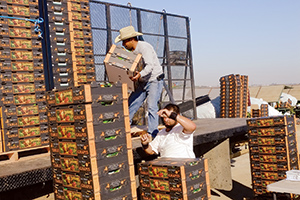Seasonal Jump in Produce Shipments Boosts Sluggish Truck Freight Market

This story appears in the June 20 print edition of Transport Topics.
A seasonal jump in June produce shipments has perked up a U.S. trucking market that has been dragged down by the country’s overall economic stagnation, industry officials believe.
“June has started strong and stayed strong,” said Mark Montague, an analyst at load board operator DAT Solutions, noting that the five busiest days of 2016 have occurred this month. “The numbers now are decent and are likely to get better with big crops that are coming in,” such as a potential record grape crop in California. “It’s usually just the last two weeks of June that are strong. With the economy struggling, this improvement is good to see, especially since produce season got off to a rough start.”
In the most recent week, DAT loads jumped 36%, an increase that’s more than expected after the four-day week ended June 4 that included Memorial Day.
“May and June have been more of a return to normal after a pretty slow first quarter due to weather-related issues,” said Michael Castagnetto, director of global sourcing for C.H. Robinson Worldwide Inc., the largest freight broker.
As demand picks up, Castagnetto told Transport Topics on June 16 that truck freight capacity still remains relatively available, but spot market freight rates and activity are increasing.
That’s a turnaround from the rest of 2016, he said, when truckload rates were weak and capacity was readily available, as measured by truck utilization.
Rates and volume also have improved this month, according to Truckstop.com, another load board operator.
The improvement is tempered by the fact that the second quarter typically is the busiest for trucking, and June is the best month for the period, analysts said.
Truck availability in the East has tightened in recent weeks as the July 4 holiday peak approaches, said Shaun Leiker, a regional manager of California-based Allen Lund Co., which ranks No. 17 among brokerage firms in the Transport Topics Logistics 50.
The recent improvement is a noticeable change from the overall produce season in Florida.
“It just seemed soft compared to last year, when capacity was tight,” Leiker said.
Demand fell off in the second half of last year and remained soft until April. Typically, he said, demand picks up in November after a few slow months.
Freight rates are down between 3% and 10% from last year, Leiker said.
Dan Vache, vice president of supply chain management for the United Fresh Produce Association, said that the 2016 truck market for shipping produce has been solid.
As in every produce shipping season, weather is a dominant force, Vache said, particularly in drought-stricken California.
“Drought should still be a concern,” Vache said, even though there was more rain and mountain snow this year compared with the recent past, because thousands of acres remain unplanted in the San Joaquin Valley.
Castagnetto explained that farmers allocate water on a multiyear basis to nourish trees or plants that have higher yields over the long term.
For example, Vache cited California growers’ water allocation to tree nut crops, while cotton and alfalfa planting has declined.
Castagnetto offered another example of weather effects by citing simultaneous May issues in California, Florida and western Mexico.
C.H. Robinson, which ranks No. 4 on Transport Topics Top 50 list of the largest logistics companies in North America, adjusted because “we are a global company and can look for supply of product in multiple areas. Our logistics capability allows us to maximize efficiency,” Castagnetto said.
A lot of crops have been thrown off, Montague said, by alternating hot, wet and cold weather.
California strawberries, lettuce and broccoli were hurt initially before returning to normal patterns.
While California has fared better, heavy rains in Texas have pushed down crop production by 25%.
Mexico-sourced produce has increased to replace crops damaged by Texas weather. A new bridge at McAllen, Texas, has helped to speed shipments to the Midwest and eastern United States, compared with past routing through border crossings as far west as Arizona, Vache said. Cross-border truck freight also has been supported by adding facilities near the border to transfer produce between Mexican and U.S. truckers.
In the Pacific Northwest, a strong cherry crop should stimulate truck demand, Vache said.
In the Midwest and Northeast, apples and peaches have been held back by particularly cold late spring weather right after warmer temperatures began the growing process, Vache said.


